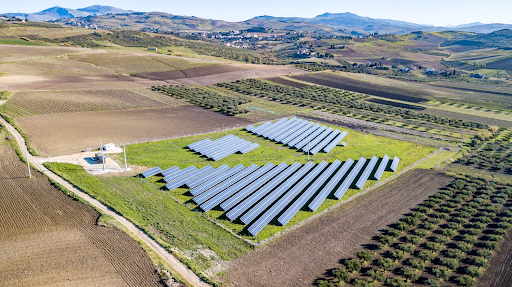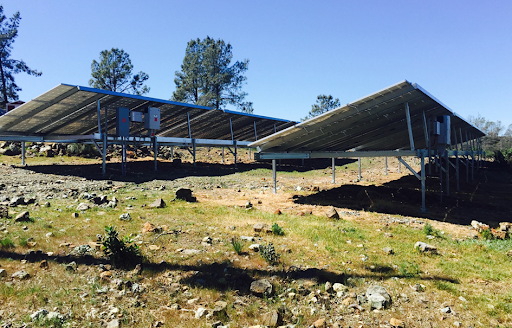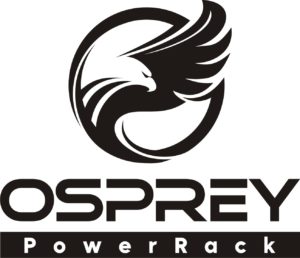What’s The Cheapest Ground-Mount Solar Installation System?
Key Takeaways
- Ground-mount solar systems may cost more than roof-mounted systems but are easier to maintain and more scalable.
- Choosing the right ground-mount solar depends on budget, space availability, and energy production needs.
- The cost of these systems depends on factors like material quality, installation complexity, size, etc.
- Nuance Energy’s Osprey PowerRack™ is a cost-effective ground-mount solar racking system because it can be installed quickly without much labor and heavy machinery.
Cheapest Ground-Mount Solar Installation System
The cheapest ground-mount solar installation system is the traditional ground-mount, which uses a metal frame that secures solar panels to the ground.
It can be set up with basic tools and materials and does not need deep foundations or specialized anchoring systems, which lowers costs.
| Nuance Energy is your superior solution for Ground-Mount solar. Our patented foundation technology, in the Osprey PowerRack™, allows for rapid installation using only handheld tools, significantly reducing both time and costs compared to traditional racking systems. This cutting-edge technology works for residential and commercial installations, and Nuance Energy empowers solar installers to take back control of their installation schedules, control project COGS, gain market share, increase the speed of installation, and reduce costs and labor. In contrast, a traditional ground-mount is much more unpredictable, slower, and costly.
Find out how Nuance Energy can accelerate your solar projects with the Osprey PowerRack™ line, and boost your profitability.
Contact us today to discuss our innovative ground-mount solutions. |
Other Types Of Ground-Mount Solar Installation Systems

You can also install solar with pole-driven mounts, concrete footings, and helical screw mounts.
1. Pole-Driven Mounts
With pole-driven solar mounts, solar panels are installed on single or multiple poles elevated above the ground. Panels can be placed at a greater height to minimize shading from nearby trees or structures and maximize sun exposure.
Pole mounts can also be equipped with tracking systems that adjust the panel angle throughout the day to follow the sun’s path and increase energy production. Suitable for locations with limited ground space, it’s used in residential, commercial, and agricultural applications.
2. Concrete Footings
Concrete-based ground mounts provide a stable and durable foundation for solar installations, especially in areas with unstable or soft soil.
However, concrete foundations require excavation and can increase installation time and costs.
3. Helical Screw Mounts
Helical screw foundations use metal screws that are driven into the ground to anchor the solar panels. This method is faster to install compared to traditional concrete footings and is effective in sandy or clay soils.
The helical design allows for easy removal or relocation of the system if necessary – a good option for temporary installations.
Key Cost Components Of Ground-Mount Solar Installations
1. System Costs
- Solar Products: The core components like photovoltaic (PV) panels, inverters, and possibly batteries for energy storage. The cost varies based on the type and efficiency of the panels chosen, and the capacity of the system measured in kilowatts (kW).
- Mounting Equipment: Ground-mounted systems require strong frames and mounting structures to hold the panels at optimal angles for sunlight exposure. The cost will depend on which mount is used: traditional mounts, pole mounts, tracking systems, etc.
- Installation Labor: Labor costs can vary widely depending on the complexity of the installation and site conditions. Ground-mounted systems generally require more labor than rooftop systems due to their structural needs.
2. Site Preparation Costs
- Land Clearing: Removal of vegetation, rocks, or other obstacles that could impede installation.
- Landscaping: Some jurisdictions require landscaping around installations to minimize visual impact.
4. Maintenance and Operational Costs
- Vegetation Management: Regular maintenance is needed to prevent shading from surrounding vegetation, which can affect energy production.
- Accessibility Requirements: Adequate spacing between rows for maintenance can increase land requirements and associated costs.
5. Permitting and Regulatory Compliance
Ground-mounted solar installations may face more stringent permitting processes compared to rooftop systems. This can include zoning laws, building codes, and environmental assessments, which may necessitate hiring consultants or legal professionals.
Why Osprey PowerRack™ Is The Most Cost-Effective Solar Installation System

Nuance Energy has designed Osprey PowerRack™ to reduce labor costs and installation time.
Our Osprey PowerRack™ is considered one of the most cost-effective solar installation systems. Here’s why:
- Reduced Labor Costs: The Osprey PowerRack™ allows for a faster installation with fewer skilled laborers. A small crew of just three to four people, with minimal training, can assemble a 10kW structure in about an hour.
- Elimination of Conventional Foundations: We use a patented earth anchor foundation system which doesn’t require traditional foundation methods such as pile-driven foundations or concrete piers. This simplifies the installation process and reduces site preparation costs.
- No Heavy Machinery Required: Unlike many conventional systems that require heavy machinery for installation, the Osprey PowerRack™ can be installed using standard handheld tools. Contractors can save significantly on equipment rental or purchase costs.
- No Geotechnical Reports Needed: Our unique real-time soil condition anchor load testing technology eliminates the need for geotechnical reports, which can be both time-consuming and costly.
- Faster Installation Time: Using our Osprey PowerRack™ system, contractors can complete projects much faster. For example, a 2MW installation can be operational in just 16 days, compared to over 60 days using other methods.
Frequently Asked Questions (FAQs)
What is a ground-mount solar system?
A ground-mount solar system consists of solar panels installed on frames anchored into the ground, rather than on rooftops.
What are the benefits of ground-mount solar systems?
- Flexibility in Location: They can be placed in open areas with minimal shading.
- Ease of Maintenance: Being at ground level makes cleaning and maintenance more accessible.
Are ground-mounted solar systems cheaper than rooftop systems?
Usually, ground-mounted systems have higher upfront costs due to additional materials and labor involved in creating a sturdy support structure.
What ongoing maintenance do ground-mount solar systems require?
Maintenance includes regular cleaning to remove dust and debris, vegetation management to prevent shading, and periodic inspections to check that all components are functioning correctly.
What types of projects can benefit from Nuance Energy’s solutions?
Our solutions can be applied across various sectors, including:
- Agriculture: Helping farmers reduce energy costs and improve sustainability.
- Disaster Recovery: Providing portable power solutions for emergency response.
- Commercial Installations: Scalable systems that can meet large energy demands efficiently.
- Military Applications: Mobile and transportable solar solutions for field operations.
Save Time & Money on Your Next Solar Project
Request a QuoteRECENT POSTS
- DPW Solar vs Nuance Energy Mounted Solar Options: Cost & Benefits
- Geotechnical Report Cost & Requirements For Solar Projects
- Are Solar Panels Worth It In Nevada? Costs & Options
- OSPREY PowerRack Ground Mount System Compatibility: Single- and Dual-Axis Trackers
- Rammed Earth Foundation For Solar Arrays: Cost, Pros & Cons
- Agrivoltaics Explained: Solar & Agriculture Combined
- Large Scale Solar Systems Options: Pros & Cons
- Best Solar Options For Farms & Agriculture: Cost, Pros & Cons
- Unirac vs MT Solar Mounted Options: Cost & Benefits
- IronRidge vs Grengy Mounted Solar Options: Cost & Benefits

